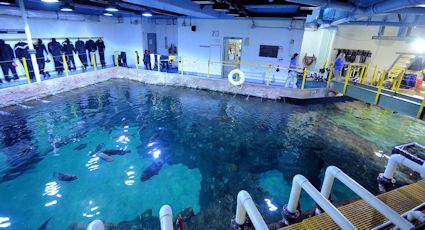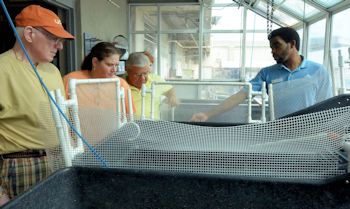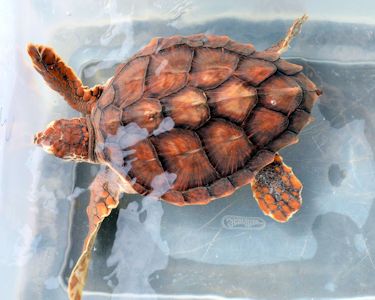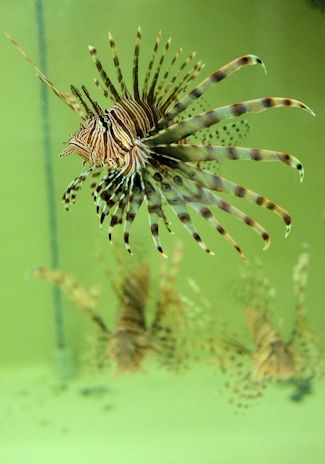 Visitors get a bird’s eye view high above the 235,000-gallon Cape Fear Shoals exhibit. |
KURE BEACH — A sand tiger shark glides past my head as I stand inches away from the glass exterior of the Cape Fear Shoals exhibit, but I am not gaping at the long, sharp teeth that protrude from its jaw like mangled fingers. After taking the “Extended Behind the Scenes” tour at the Fort Fisher Aquarium, I no longer look at these mysterious species as pieces of living art swimming around on display. The tour is something like learning the tricks of a magician. Now when I see an exhibit I can appreciate what it takes to produce the magic of this aquarium.
Supporter Spotlight
The Fort Fisher Aquarium’s two-hour tour gives visitors access through the “staff only” doors to learn how the tanks are kept clean and clear and how the animals are collected and cared for. Visitors witness the science experiments that are taking place and the new species that are getting ready for debut. The tour concludes atop the largest exhibit tank to watch the sharks feed.
Joseph, the tour guide, led our small group through the aquarium entrance and then immediately through an unassuming door into the freshwater life-support conservatory. The first thing we encountered was the dangerous animal holding area, two chambers with glass doors. This is where the alligators, cottonmouths, copperheads, diamondback rattlers and poisonous dart frogs come to rest after being on exhibit or if they become sick.
 Joseph, right, the aquarium’s guide, leads visitors on a behind-the-scenes look at the pumps and filters that make the magic happen. |
Through the glass door that read “authorized personnel only: venomous snake quarantine,” we could see the lethal creatures sitting up and watching us from the windows of their black containers. Hooks used by those qualified to handle the snakes hung on the other side of the wall.
Supporter Spotlight
Along the tour Joseph shared some interesting facts about the animals at the aquarium, like the not-so-poisonous dart frogs. In their natural environment, dart frogs accrue poison from their diet of ants that feed on poisonous plants. The dart frogs at this aquarium, however, have a diet of flies and therefore are not poisonous.
Through the corridor we pass multiple filtration systems that keep the tanks clean and clear. The ultraviolet sterilizer is larger than a man. It bombards water with radiation to kill microbes and microorganisms, filtering them from the water. Just next to it, the high-rate sand filters use sand as a physical barrier to trap solid waste materials in the water.
The concrete walls around these filtration systems are also lining parts of the fish tanks. The group learns that concrete will make water basic. So while the world’s oceans face acidification, the aquarium tanks require a pH monitor that triggers an automatic acid pump dispenser to release acid and balance the water’s pH.
Standing next to brown paper sacks of salt piled on the ground, Joseph notes that in natural freshwater habitats the water is usually brownish or yellowish in color but in the aquarium the water is always clear. Ozone sterilizers are used not only to sterilize water but also to reduce its coloration. And, trace amounts of salt (two to four parts per 1,000) are used in the freshwater to keep tanks clean.
 |
 Those on taking the tour get up close with porcupine puffer fish, top, and baby loggerhead sea turtles. |
Exiting the building we step outside under the blue sky to inspect a giant freezer housing the “restaurant grade” seafood for the animals—mackerel, squid, shrimp, blue crabs, clams and other fish.
“I like to joke around and say they eat better than me,” said Joseph.
Photos by Tess Malijenovsky |
Without delay he directs us into the freshwater quarantine. Like bugs drawn to a lamp in the dark, we gather around terrariums lining rows of metal shelving. Heat lamps glow inside each. They keep the reptiles and amphibians warm. The animals used in the educational programs that teach kids about the local wetland environment
The room is gurgling with the sound of yet more filtration systems. Scattered on the floor are tubs of water with floating black spheres that look like the prickly balls of a sweet gum tree. Although small in size these bio-balls are cleverly designed to maximize surface area and produce beneficial bacteria to eat any waste materials dissolved in the water.
The group gets a good look at the docile baby American alligators that were confiscated from a pet owner. Here they will be given names and taught how to target food —bumping a plastic pipe with their noses and then opening their mouths for food. “Until they do that they don’t get food, and they learn pretty quickly,” Joseph said.
The tour continues outside where we see a woman dangling her legs off the ledge of some steps, soaking up the sunshine next to a few baby loggerhead turtles. I watch a loggerhead turtle for the first time as it swims perpetually inside its Tupperware of water and admire its exquisite shell, or carapace, and little, dexterous fins.
The baby turtles have just arrived from the beach. Each year, the Fort Fisher Aquarium receives three baby loggerheads and releases them back into the ocean once they turn a year old.
We’ve arrived at the back door entrance of the two-story saltwater life support conservatory and quarantine building. The Fort Fisher staff takes trips offshore to collect new species for the aquarium. The new animals will spend at least 30 days in quarantine to ensure they aren’t carrying any bacteria or illnesses and also to give them time to adjust to captivity.
Fort Fisher aquarium reproduces its own brine shrimp and moon jellyfish to feed other animals like sea turtles and sea nettle jellyfish. They also propagate baby sea horses, which they can trade along with the moon jellies to other facilities.
 Lionfish spend some time in a quarantine tank before being put on public display. |
Sometimes recreating a species’ natural environment requires thinking outside the box. Sea nettle jellyfish, for example, cannot live in rectangular tanks because the corners create “dead spots” where the jellyfish can ball up and tangle their tentacles. So while their exhibit appears to have a rectangular shape from the visitors’ perspective, behind the wall is a circular tank.
Upstairs Joseph shows us the invertebrate holding for crabs, sea stars, sea cucumbers, urchins, hermit crabs and horseshoe crabs. This floor rumbling with construction is also where the food from the freezer outside is prepared with vitamins and minerals. Sharks and rays, for example, require extra calcium. Vegetarian species may snack on saltwater or freshwater gels made with vegetables or phytoplankton.
Often a variety of fish foods is dumped into the same tank so that fish can enjoy a dietary smorgasbord. Even within the same species certain individuals prefer different foods. If the staff notices an animal that is having difficulty reaching food fast enough they’ll try to target feed it. If it goes on for too long they catch the animal and put it back in quarantine to nurse it back to health.
The tour ends with a shark frenzy at our feet in a tank as wide as a swimming pool. It’s feeding time for the 84 animals living in the 235,000-gallon Cape Fear Shoals exhibit tank, the largest in the aquarium. From a railing we watch an employee target feed sandbar sharks and sand tiger sharks from a bridge across the tank. On the other end of the tank, two employees scatter feed for the other 22 species by throwing handfuls of food into the water. Sheldon, the green sea turtle, is fed separately in a box that he’s learned to swim into for his food. After all our questions have been answered and curiosity sufficed, Joseph leads us back to the visitor’s side, but now we’re visitors with a new appreciation and respect for the aquarium.
The Extended Behind the Scenes tour takes place every Wednesday and Friday at 2 p.m. The charge is $20 for adults.You can also choose a similar but shorter tour – no shark tank — for $15. That one is at 11:15 a.m. on Saturdays and on Sundays at 11:15 a.m. or 1:15 p.m. Reservations can be made online.







